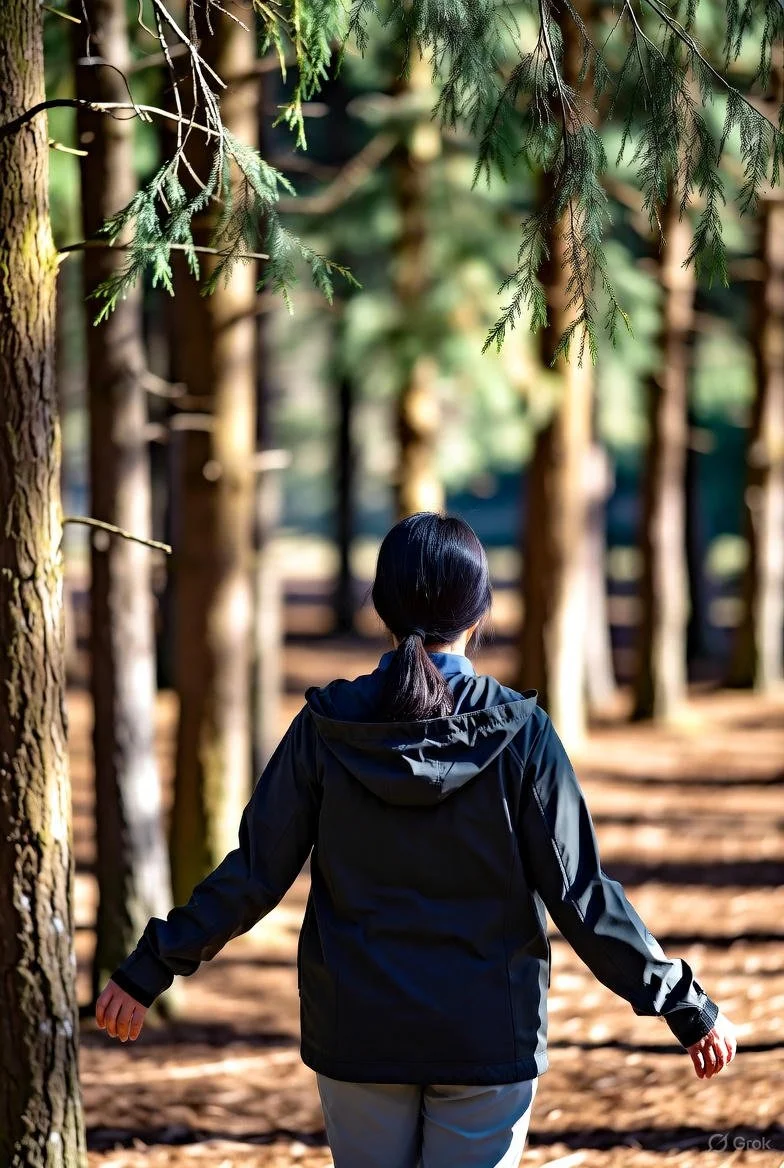Why Forest Bathing is Your Natural Path to Inner Peace
Forest bathing could be exactly what you need to counter modern urban living stress. The World Bank reports that urban areas now house 56% of the world's population. This number will likely grow to 70% by 2050. Our increasing distance from nature makes the Japanese practise of forest bathing a powerful way to rebuild our connection with the natural world and restore our well-being.
Let's talk about what forest bathing really means. Japanese health experts developed this practise in the 1980s to address rising stress-related health problems. Known as Shinrin-Yoku, it encourages people to mindfully connect with forest environments. Science strongly supports its healing power. Studies reveal that it lowers cortisol levels (our stress hormone). People who took a two-hour forest walk slept 15% longer. A 2010 study showed something remarkable - walking in forests twice daily for two hours boosted cancer-fighting proteins and immune cells. Trees release compounds called phytoncides that help explain these benefits. These natural oils strengthen our infection-fighting cells.
This piece explores forest bathing's rich history and science-backed benefits for your body and mind. You'll learn practical ways to make this healing practise a regular part of your life. Forest bathing can be your natural path to inner peace, whether you want to reduce stress, think more clearly, or feel more connected to nature.
The roots of forest bathing: culture, history and meaning
Japan's story of forest bathing comes from a country where forests blanket about 67% of the land. The Japanese culture has deep roots in these woodland environments. The practise we know today, however, started much more recently.
Forest bathing history and Japanese origins
The Forest Agency of Japan created the term shinrin-yoku (forest bathing) in 1982. This wasn't just a random idea. The practise responded to two major concerns. Japanese society needed an answer to the tech revolution and stressful lifestyles that spread faster than their traditional nature-focused way of life. The practise also helped Japanese people build a stronger bond with their natural surroundings.
The practise tackled a serious health crisis in Japan. The Japanese even had their own word—karoshi—which meant "death from overwork." This showed how much stress-related illnesses affected people's lives. With Japan's rich forest resources, forest bathing became an available solution.
The philosophy behind Shinrin-Yoku
At its heart, shinrin-yoku reflects the Japanese belief that humans and nature share a deep connection—in body, mind, and spirit. Unlike hiking to reach a destination, forest bathing lets people wander slowly without a goal, staying fully aware of their surroundings.
The practise draws wisdom from old Shinto and Buddhist traditions that highlight nature's spiritual and healing powers. Shinto beliefs say that spirits called kami live in natural elements, including trees, which deserve our respect. Buddhist teachings also promote living in harmony with nature, seeing all life as connected and dependent on each other.
Concepts like yūgen, komorebi and wabi-sabi
Three traditional Japanese ideas are the foundations of forest bathing practise:
Yūgen describes feeling nature's beauty so deeply that words can't express it—a deep appreciation beyond language.
Komorebi means "sunlight filtering through trees." It captures those magical moments when light plays through the forest canopy.
Wabi-sabi celebrates finding beauty in imperfection and change. This idea teaches us to see wonder in nature's quirks and cycles—from twisted tree trunks to fallen leaves. It reminds us that nothing lasts forever.
These concepts make forest bathing more than just a break from city life. They offer a complete philosophy to help us reconnect with our natural roots.
How forest bathing heals the body and mind
Our bodies react the moment we step into a forest. Nature's healing power works at basic levels that modern medicine doesn't deal very well with, especially when we connect with it purposefully.
Forest bathing healing through sensory immersion
The healing power of forests comes from full sensory participation. Forest bathing stands apart from regular outdoor activities because it asks us to use all five senses to connect with nature. This mindful connection helps us focus less on negative thoughts and leads to more positive mental states.
Our bodies naturally line up with the forest's rhythms as we immerse ourselves in nature. This alignment releases tension and helps us renew both physically and mentally. Forests give us many healing elements: scenic beauty, oxygen-rich air, soothing bird songs, natural plant antibiotics, and negative oxygen ions.
Scientific studies on cortisol and immunity
Research shows clear physical benefits of forest bathing. Studies prove that it lowers cortisol, our main stress hormone, by a lot. People who walked in forests had 12% lower stress hormone levels than those who walked in cities. Their blood pressure and heart rate dropped too.
Japanese researchers found that there was something even more amazing - forest bathing boosts our immune system by increasing natural killer (NK) cell activity. These cells play a vital role in fighting pathogens and reducing oxidative stress. The immune system boost lasted more than a month after people visited the forest!
Mental health improvements: depression and anxiety
Forest bathing helps mental health as much as physical health. A comprehensive review shows it reduces depression and anxiety symptoms by a lot. People feel less nervous, angry, tired, and confused after forest bathing sessions.
University of Michigan researchers studied how forest walks affect people with depression. They learned that nature experiences are a great way to get additional help alongside regular depression treatments. Forest therapy also shows promise in helping people heal from trauma and PTSD.
The psychological benefits last long after the forest experience ends. Office workers felt more relaxed for three to five days after their forest therapy sessions.
Steps to start your own forest bathing practise
You don't need special equipment to start your forest bathing trip - just an open mind and be willing to connect with nature. Here's how you can begin:
Find a safe and peaceful natural spot
Look for a nearby natural area where you feel comfortable—maybe a local park, nature reserve, or even a small urban green space. Your ideal spot should let you disconnect from technology and urban noise. Forests give you the richest experience, but any safe natural setting works well.
Walk slowly and observe without judgement
The moment you step into the forest, slow down to half your usual pace. Forest bathing isn't like hiking where you need to reach somewhere. Let yourself wander without purpose and follow what catches your eye naturally. You'll notice small details that usually go unnoticed when moving faster.
Use your senses to connect with the environment
Your senses should guide you—feel the tree bark, listen to bird calls, and watch sunlight dance through leaves. Sensory immersion makes forest bathing special. Listen to sounds both close and distant, and feel different textures and temperatures on your skin.
Practise deep breathing and stillness
Deep breaths from your belly help you relax, with exhales lasting twice as long as inhales. This way of breathing tells your body it's time to unwind. Find a cosy spot to sit quietly and just be present with your surroundings.
Avoid multitasking or goal-setting
We mostly left our phones behind or switched them to aeroplane mode. This isn't about counting steps or meeting workout goals—it's about being present. Let go of any plans and allow yourself to relax completely.
Making forest bathing part of your lifestyle
Making forest bathing part of your daily life needs more than just occasional nature visits - it needs dedicated practise. A well-laid-out routine helps you get all the benefits over time.
How often should you do it?
The regularity of your practise matters more than how long you spend. Research shows that people who spend at least 120 minutes weekly in natural settings see substantial health improvements. Your immune system gets a boost from monthly forest bathing sessions. Studies reveal that natural killer cell activity stays elevated for seven days after just one forest visit. Just like any other wellness practise, regular involvement brings lasting benefits. So, even quick daily nature connections add up to better health.
Urban alternatives and adaptations
City life shouldn't stop you from forest bathing. You can use urban parks, rooftop gardens, or small green spaces instead. Your home can become a nature sanctuary with potted plants, natural items like stones or pinecones, and forest-scented candles. The key is to disconnect from technology. Step away from screens to let your senses blend with natural elements. Some city dwellers use headphones with nature sounds when they can't find enough green space.
Using forest bathing as a mindfulness tool
Forest bathing healing works because it keeps you focused on the present moment. Start your day by appreciating nature. You can weave brief mindfulness exercises inspired by your forest experiences into your daily routine. Notice your breath, accept distracting thoughts without judgement, and gently bring your focus back. This portable approach helps you carry forest bathing's benefits beyond the woods.
Combining with yoga or meditation
Nature forest bathing pairs perfectly with other mindfulness practises. Outdoor yoga makes both experiences better. The earth beneath your feet helps deepen poses, and forest settings naturally help you stay present. Tree Pose or Mountain Pose feel right at home among real trees. Meditation in nature boosts both practises through cooperative effects on mental wellness. Yes, it is common for people to feel more relaxed when they combine these approaches.
Conclusion
Forest bathing serves as a powerful remedy for our growing disconnect from nature in modern life. This Japanese practise goes beyond a simple walk among trees. It provides an integrated approach to wellbeing that's deeply rooted in ancient wisdom and backed by modern science.
Research confirms what our ancestors knew deep down - nature heals us. Time spent in forests lowers our stress hormones, strengthens immunity, helps us sleep better, and reduces symptoms of depression and anxiety. These positive effects continue long after we leave the trees and boost our overall quality of life.
You only need to be willing to start your own forest bathing practise. There's no need to travel far or buy expensive gear. People living in cities can adapt these principles to any green space they find. Success comes from being present - taking time to notice the natural world around you.
Forest bathing gives us something rare in our achievement-driven world: permission to just be. Unlike other wellness trends, this practise asks us to let go of goals and focus on our senses instead. This fundamental change from doing to being explains why it restores us so deeply.
On top of that, forest bathing works perfectly with other mindfulness practises. Natural settings make yoga, meditation, and deep breathing more effective. These practises combine to help us stay balanced when life gets challenging.
Without doubt, getting back to nature fills a basic human need. We remain biological beings who evolved in natural settings, despite all our technology. Forest bathing recognises this truth and gives us practical ways to honour it.
This piece invites you to step away from screens, deadlines, and city noise - even if just for a while. The forest stands ready with its timeless medicine for modern problems. Your journey to inner peace might start right under those tree branches.
Another Blog Post by the Secret Forester






